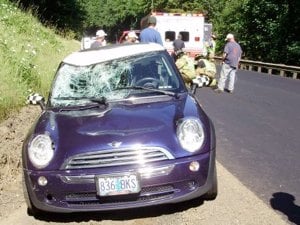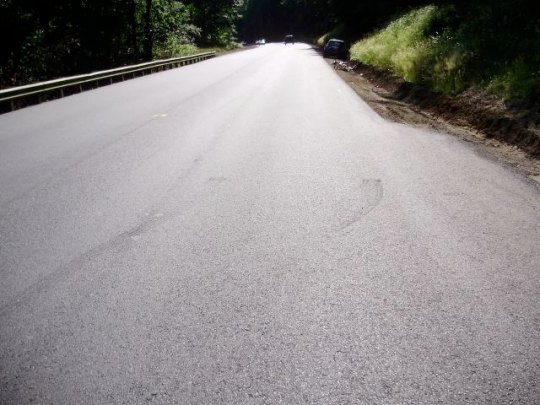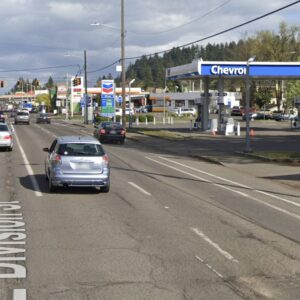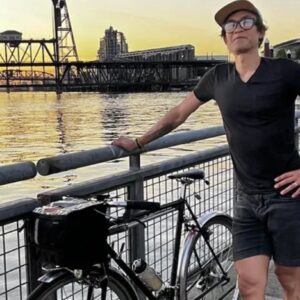
(Photo: Oregon State Police)
The Oregon State Police are investigating a collision that happened yesterday afternoon on Highway 6 (Wilson River Highway) east of Tillamook. According to an OSP statement, 29-year old Portland resident Joel Westrom was riding westbound on the shoulder of the highway when he was struck from behind by Suzanne Flood, a 65-year old Milwaukie resident driving a Mini Cooper.
The OSP statement says Westrom, “reportedly moved into the car’s path” prior to the collision. Investigators believe Flood was driving 55 mph prior to the collision. Westrom has sustained serious injuries and was flown to OHSU. The police statement also says he was not wearing a helmet.

(Photo: Oregon State Police)
I was disturbed by the “moved into car’s path” statement in the press release so I called OSP Public Information Officer Lt. Gregg Hastings. Hastings said the investigation is still ongoing, but roadway evidence (location of skidmarks in above photo for instance) and the statement of the driver have led to the initial hunch that Westrom might not have been riding on the right in the shoulder prior to impact. Another reason Hastings gave for this assumption is that a popular hiking trailhead (Kings Mountain) is very close to where the collision occurred. “The person might have pulled out and gone wide into the road, possibly crossing it, based on the roadway evidence,” he said.
Worth noting is that this highway is part of a coastal biking route recommended by the City of Portland Bureau of Transportation on their “Recreational Bicycling Rides” page. This collision occurred near milepost 25, which is close to Lee’s Camp Store and the Elk Creek Campground. According to the elevation chart supplied by PBOT, it also appears this was a downhill section of the road. The collision occurred at around 4:00 pm, so the sun would have been bright and glare could have also been a factor. Also worth noting is that the road has recently been repaved, so there is no lane striping to designate where the shoulder area begins.
So far, Hastings says, they have not interviewed Westrom to hear his side of the story. We’ll update this post when we know more.





Thanks for reading.
BikePortland has served this community with independent community journalism since 2005. We rely on subscriptions from readers like you to survive. Your financial support is vital in keeping this valuable resource alive and well.
Please subscribe today to strengthen and expand our work.
Looks like the road narrows right there, perhaps the cyclist was moving tot he left to stay on the asphalt. Interesting that the skids seem to come from the left as well, like maybe the mini was attempting a pass and had to pull back over quickly? All speculation of course.
Too many injuries out there, I hope Joel makes a full recovery.
The skid marks clearly show the driver is heading towards the side of the road when they were applied. The question to ask is WHY? Was the driver on their cell phone, looking at trees, or did they have the psychopathic urge to hit a biker? If the driver was paying attention they would see that the pavement for the biker is ending and they would have to move left (this is NOT an unusual circumstance). The motor vehicle is damaged on the right-side of the front, indicating the biker was on the far side of the road when the car hit them. The skid marks show the road size nicely, as well as the direct the car was moving. The size of the road is large enough to easily accommodate the motorist and the bicyclist. This is absolutely the fault of the driver, who has the responsibility of putting the safety of pedestrians and bicyclists first. Regardless of why the incident occurred there is no indication that the bicyclist was doing anything other than riding their bike on the side of the road. The question therefore remains, how did the motor vehicle end up going towards the side of the road and hitting the bicyclist?
Motor vehicle has a big horizontal dent on the hood, bashed in right side windshield, caved in upper body windshield frame member. One guess I have, is that the cyclist’s hip/buttocks colliding with the hood was the first impact, then his hip/buttocks colliding with the windshield, back/shoulder and colliding with the car’s upper body windshield frame member being the secondary impact.
No word yet to the public, about how Joel Westrom, the person that was riding bike is doing as far as recovery from his injuries.
Considering how the body hit the car, it indicates that the bicyclist was riding directly forward when the vehicle hit them, the head of the body arched backwards (since the back wheel was the first point of impact, and his body would have a pivot point on the seat). This explains the points of impact on the vehicle perfectly. The backside of the body hitting the car, with the head traveling first towards the vehicle (hitting the top of the windshield and roof-line), and the victims left elbow smashing into the center of the windshield (indicated by the circular impact crackling in the middle of the vehicles windshield). The biker likely heard the screeching of the vehicle, but had only split seconds to assess the situation and take action (the bicyclist did not have enough time to do anything defensively against the oncoming car).
The lack of lane markings likely played a major role in this accident, but it’s still the responsibility of an approaching driver to accommodate forward road users and slow the F down. Also, the driver’s age.
The driver’s claim that the cyclist “swerved” into her lane is absolutely hogwash. Just look at the damn skidmarks that went to the right towards the shoulder! Can’t wait for a civil judgement to excoriate the driver for lying.
Not hogwash. Cyclists regularly change lanes in front of cars without signaling their intent or even looking to see if it is clear and safe to do so.
It looks like after the collision the car hit its brakes and skidded to the side of the road, nothing unusual about that.
Look where the skids stop and where the Mini is actually parked — they’re so far apart that the cyclist would have been hanging on for a while before finally flying off the back of the car. The skid marks do not indicate where the Mini finally stopped.
Looking at the pictures, you will see WHERE the bicyclist had to move over…and the skid-marks happen BEFORE this location; Meaning the car locked the brakes BEFORE the impact. The direction of the skid-marks clearly show the vehicle moving TOWARDS the shoulder where the bicyclist was traveling. The damage to the vehicle shows that the body of the cyclist was up high (meaning they were riding upright), and it shows the cyclist was traveling as close as possible to the shoulder of pavement. (If the bicyclist was moving across the lane, the momentum would have kept his body going in that direction…clearly that did not happen here…as the damage is very far to the right front side of the vehicle). The likely body impact is the head hitting where the top of the windshield meets the vehicles roof, and the victims elbow smashing into the center of the windshield (the large circle pattern in the windshield).
what relevance is driver’s age?
Statistically, older drivers suffer decreases in senses, reaction times, and general awareness — the natural decline of abilities associated with aging.
The lack of markings by the State Transportation Board (common for repaved roads), the lack of a helmet by the bicyclist (not a factor in the cause of the incident), the sharp ending of shoulder pavement (again, a common roadside occurrence), the direction of sunlight (something we all contend with while driving), and any other factors are irrelevant, because they do not cause vehicles to travel towards and into the shoulder of the roadway. I agree with you that the skid marks clearly show this car going in the direction of the biker…a direction that is very different from traveling straight along the road or having to veer left to avoid a biker. There is no doubt this car headed straight for that biker, which was clearly (and legally) traveling on the shoulder side of the roadway pavement. It is the legal (and moral) obligation of all drivers to put the safety of pedestrians and bicyclists first. I do not see any legitimate reason this driver would be heading towards the side of the roadway where a biker is clearly traveling. I can understand the motives why a driver would say anything (including lies) in order to cover themselves of any wrongdoing in such a case…but I cannot understand why a professional police department cannot look at the evidence staring right in front of them, and would ignore it and make statements that clearly favor the drivers side (the one who is clearly at fault).
Once again we have an Oregon tourism organization promoting cycle tourism in unsafe areas, and then sitting on their hands and not getting involved / making a statement when cyclists following their recommendations are injured or killed. It disturbs me that they don’t feel they have any responsibility to at least make a statement in these types of cases.
Hwy 6 is perfectly safe in most areas – Cycle Wild has led more than a dozen trips along that route without incident, and bike/car collisions on Highway 6 between the Forest Grove / Banks area out to Tillamook are very rare. Even car fatalities are rare on Hwy 6 – most of the highway fatalities are on Hwy 26 to the north.
what the previous two commenters said –
1. road narrows, requiring cyclist to move left to stay on pavement
2. skid marks indicate driver was veering right towards the shoulder
3. No lane markings to indicate to the driver that there is a shoulder/bike lane that they should not be driving in.
Hard to tell looking at it in the above picture, exactly what the skid mark path indicates about cause of the collision. End of the skid marks doesn’t necessarily indicate point of impact, which could have been further in advance of their end point, and before the motor vehicle apparently moved somewhat to the right.
Looks like the car’s hood has a big dent centered across and close to the front of it, suggesting the hood, rather than the windshield, was the initial point of impact on the motor vehicle. Weird, horizontally elongated dent. Learning what Joel Westrom’s injuries were, may give a better sense of the path his body traveled relative to the motor vehicle’s surface, once he was hit.
The TV news has already blamed the cyclist with the “swerved into the drivers path” comment and of course he wasn’t wearing a helmet which infers that he is irresponsible. Too many collisions!
I would like to take a poll of every driver that hits a cyclist and how many says “The cyclist swerved in front of me.” I would imagine that it would be pretty high. In fact, I imagine almost all cyclists swerve in front of drivers. You know, that’s what we do. Especially in shoulderless, back-forest roads where visibility is limited and people are known to drive over the speed limit.
Not as high as “I didn’t see him/her”!
i’m pretty sure this has been stated before but Washington County Sheriff’s Department has stated [when being interviewed for a rash of encounters on Hwy 26] when on roads in Oregon it is illegal to drive on the shoulder – they are for emergency use only. Bikes are seen as cars in this instance according to WashCo and so having OSP state that the bike was not on the shoulder means the bicyclist was following the law – they should not be able to hold that against him. Tragic none-the-less.
This isn’t in Washington County – it’s in Tillamook County. Washington county ends at the Roger’s camp area summit near mile marker 33 – 8 miles to the east of the incident site.
Regardless, the Oregon law he mentions is state-wide and accurate.
What others have said. It is a shoulder, not a bike lane and a rider has full use of the road way. There is often a lot of debris in the shoulder and you have to move over some times.
It is your responsibility as a vehicle operator not to rear end other vehicles.
Ed
This section of HWY 6 is pretty terrifying. I’m actually surprised that this is considered an acceptable route to the coast for cyclists. You would definitely need some balls to take the lane here, as the drivers are going 60+mph, but the shoulder is only about 1ft wide in some places, so options are not good…
It will be interested to see what the investigation yields. I would not assume from the skidmarks that the driver swerved and hit the cyclist. If the cyclist did in fact move to the left side of the westbound lane, the driver may have skidded and swerved to the right to avoid him. The location of the impact relative to the skidmarks is critical here.
Based on the photo, the cyclist hit the passenger side of the windshield; if the rider was moving left to cross the road and the driver swerved right to avoid the cyclist, I would expect the impact to be on the driver’s side of the vehicle, rather than the passenger side.
“Based on the photo, the cyclist hit the passenger side of the windshield; …” BURR
Second point of impact, probably. A possible scenario is that the driver may in fact have been on a straight track down the center of the main lane at the point of impact. Upon collision after having locked the brakes and skidding the tires in an unsuccessful, attempt to avoid hitting the cyclist, turning the car to the right side of the lane, away from opposite direction traffic would be the thing to do.
That’s a bit of exaggeration. The shoulder narrows to 3′ in many sections, but no narrower except in one spot on the eastbound side. (pre-the most recent repaving) The only hazardous area is the hillside leading up to the summit near Roger’s Camp. Once you get past Elk Creek on the westbound side, the shoulder tends to be about 4-5′ in most locations, and really wide out near the Tillamook Forestry Center and in the Tillamook Valley.
Highway 6 is loud. On holiday weekends, it’s busy, but not nearly as busy as the other major highways in the area. I’d recommend wearing earplugs and using a mirror. Taking the lane is indeed unsafe on that road, but in nearly every location, the shoulder is plenty wide enough for a single cyclist.
Matt,
I am in total agreement with every reply you have made here.
…and btw, I use a mirror, and just ONE earplug ,(in the left ear) just to keep the right one available for the far away sounds.
I also would like to share with those that have never used mirrors, or those who may not think about how to use them properly…
I believe it best to set the mirror up so you detect the car behind you by a 1/4 mile or so….
If you set your mirror so the car is visible at 100ft,… it is way too late.
In addition, as the car approaches, make one or two head turns to show the driver you sense them passing… This goes a long way towards letting them know you are a defensive rider, and they magically move over, unless they are jerks.
Has OSP cited any actual evidence that the cyclist “reportedly moved into the car’s path”? We hear this claim over and over and over again when a cyclist is hit by a car on a rural Oregon highway. Usually it ends up being just the uncorroborated claim of the driver of the car that hit the bike.
By the way, I have ridden this exact stretch of road, to get from one mountain bike trailhead to another. There are places where there is a “shoulder” to the right of the white stripe, but it’s only a couple feet in places. In other places it is nonexistent and you pretty much have to pray that people will move over and give you enough room.
If I’m already riding down the edge of the lane, and then a car comes by, does that count as “moving into the car’s path?” Apparently OSP treats riding on Oregon’s shoulderless highways (which are far too numerous!) the same as riding on the sidewalk: technically legal, but if you get hit by a car they WILL assume it’s your fault.
A possible scenario was that the driver mistakenly thought her lane was more to the right and suddenly corrected herself into the cyclist when another vehicle approached from the opposite lane — or perhaps an approaching vehicle encroached on her lane. I could imagine this as the temporary lane dividers in the upper left of the picture are somewhat faint.
Sadly the OSP has released another seemly incomplete traffic incident statement without information from both viewpoints of the incident or independent neutral observation.
The survivors on scene of any traffic crash are those who’s statements are taken as the record of the incident …and since most pedestrians and cyclists are typically dead or have severe trauma (and are now away from the site); the motor vehicle’s driver’s statement sets the “official view” of the crash. One can only hope the cyclist (or pedestrian) is soon able to communicate their viewpoint and also that an independent eyewitness may exist to add detail where it is in doubt.
The photo of the MV skidmarks will make for some interesting crash reconstruction…depending on where the point of impact occurred.
If only dash cams were as popular here as in Russia.
We are already being watched over enough, thank you…We also have enough Evangelicals here as well, so perhaps Russia can keep both of those items.
Additionally this incident brings up the inadequacy of many work zone safety plans during road reconstruction or restriping…especially when it comes to corridors with high speeds, high volumes and or little room for vulnerable roadway users.
Adding temp centreline striping is good for two way MV traffic but what about the importance of the a marked fog line for multimodal traffic, famers with tractors and RVers, especially in curvy zones, west/ east sun glare zones, or for night time travel? I wonder if this was a signed work zone and if the posted speed had been lowered for improved traffic safety.
There is much many State DOTs can do to improve work zone planning for multimodal traffic. (NACTO help us! Give me a call)
I’ve done some work with OSP’s troopers who do crash reconstruction, and I think they have a lot of integrity and some serious investigative chops, think of the guys on “Mythbusters.” I wouldn’t be so quick to write this off as OSP taking the driver’s word for what happened as gospel. They do, however, need some physical evidence to work with and there may not be much in this case. It’s unfortunate, however, that the press release appears to speculate as to the cause when OSP itself says the investigation is not complete.
Point well taken…
Except it *doesn’t* speculate. It says “reportedly”, which is a factual statement. Unless it says somewhere else “appears to be”, or some variation of that, then the statement is factual and unbiased. Police are required to report the witness accounts as recounted, not as what the officer thought the witness saw, or what might have occurred.
Checkered mirrors! Can only mean one thing.
This is clearly a construction zone. Was the construction zone speed limit 55mph?
I wonder if the skid marks were measured to see how fast she was indeed going.
I also wonder as well that if the skid marks are from the rear tires as it may be that the driver slammed on them and tried to turn the vehicle and the back end swung around.
Regardless, it is the the person trailing behind to avoid what is in front of them.
Measuring skid marks is a standard practice if the crash reconstruction team is called out – if not, then it’s not likely they were measured, only photographed. They *can* be measured later from the photo if not at the time of the collision.
Oh, and best wishes for a full and speedy recovery, Joel!!
Sadly the driver may be able to show no civil blame as well due to the lack of the outside white “fog line” and the police backing up the driver’s “innocence”.
As much as I want all drivers to be responsible for their actions and slow down I believe that ODOT specifically bears some serious responsibility for not installing the simple safety measure of white paint.
For the savings of a few dollars people must die.
This. Is. Wrong.
A lot depends on how long of time it is between the resurfacing and the restriping. Lowering and managing traffic speeds through these work zones is very critical – especially in regions where there is often no other good route for MV or bike traffic.
WEAR NEON!!!!!!!!!!!!!!!!!!!!!!!!!!!!!!!!!!!!!!
USE A MIRROR!!!!!!!!!!!!!!!!!!!!!!!!!!!!!!!
Try various mirrors until you find one that nails it for you. I have found the “Take a Look” eyeglass-mount units to be the best for my own use.
Remember, we share the road with subhuman, uncontrolled top of the foodchain predators. Ride and think accordingly.
Daytime running lights are my panacea. Mirrors never worked worth a damn for me; always out of adjustment, never ever able to do a “quick look” without wondering WTF the mirror is showing me.
Round here, the Mini is the sports car for those who want to keep their hipster cred. I see plenty of Mini’s driven fast.
As much as I dislike the mentality that the car is always at fault here I must admit I am sick and tired of the close calls I am having. I ride for fun/health more than I do for other reasons. I commute from time to time but when push comes to shove I would rather pack up the kids in the car vs a cargo bike. Having said that, I am amazed at the reaction I get when having these close calls. Just today I was riding down west towards the sellwood bridge and some douche turned right in front of me. I locked up the breaks and fortunately was ok other than my heart beating a bit too fast for its liking. Her reaction wasn’t apologetic in the least. No “I am sorry” but only an angry look. The more I ride the more this seems to happen and it scares the crap out of me. My point is that I am becoming more appreciative of jonathan’s fight. In my experience one can follow the rules of the road yet still get plowed over in a blink of an eye.
Well said.
And if we are knocked out or killed the fact that we were riding perfectly will not matter one iota because the driver will reconstruct the situation in their own memory to assuage their own guilt. Within minutes they won’t remember what they may have been doing wrong and the “accident” will have been virtually “unavoidable” in their minds.
hopefully fast recovery -best wishes for him.
It is interesting that there are any skid marks at all as I would think a pricey mini cooper built by BMW would have anti lock brakes on it. Most newer cars do.
Perhaps the rear brakes are not anti lock. If the front brakes were anti lock he could have still steered the car to the side of the road during full pressure stop.
Looks like he may have done the right thing and merged over a ways before the shoulder ended.
The passenger side skid mark is right where a rider would be if there was no shoulder.
Which is the case 4 feet in front of the skidmark.
Of course he pulled into the lane.
He had to.
In the picture, what’s visible of the left side skid mark furthest from its end point, suggests the motor vehicle may have been traveling down the center of the lane prior to brake application, rather than more to the right side of the lane, as the position of both skid mark end points seem to indicate the motor vehicle may have moved to during skidding.
I’ll venture to suggest that someone riding a bike in a road situation that involves having to make a merge from a section of road with a paved shoulder, to one without a paved shoulder, as seen in the picture…generally would change their direction of travel as they made the transition between the two sections, so as to have themselves riding 2′-3′ away from the road’s edge, depending upon traffic at the time of having to make the transition.
I just saw similar damage on a grey/blue toyota pickup. Very little bumper damage but a smashed in passenger side windshield. If anyone is aware of a hit-and-run involving such a vehicle, I can give further info to the police.
One thing I haven’t seen anyone mention in my quick scanning of the article and comments is Oregon’s “safe” passing law (811.065), which states “a ‘safe distance’ means a distance that is sufficient to prevent contact with the person operating the bicycle if the person were to fall into the driver’s lane of traffic.”
It’s subject to some interpretation, but when I am on my bike, I’m sitting with my head roughly 6 feet above the ground. If I were to just tip over into the roadway, it would put my head 6 feet to the left of where my tires were. Therefore, a safe passing distance is a minimum of 6 feet from the bicycle’s tires’ point of contact.
As an armchair crash reconstructionist, I say that if the point of impact is determined to be less than 6 feet from the edge of the roadway, then it constitutes prima facie evidence of unsafe passing by the driver.
If a bike and a motor vehicle traveling down the same road, are each holding their respective line of travel, with the motor vehicle maintaining safe passing distance as specified 811.065, that should eliminate the chance of a collision occurring should the person on the bike happen to fall over, somewhere during the time the motor vehicle is close to, or is passing the bike.
Part of deciding whether a driver is guilty of ‘Unsafe passing of person operating bicycle’, depends on determining whether or not a given motor vehicle did or could hold its’ line and safe distance from the person on a bike it approached.
But the safe passing distance definition is constructed in terms of a cyclist not holding his line of travel, i.e., falling over.
If a motorist “could not” initiate the pass at a safe distance, then hold that line for the duration of the pass, I would ask what precluded the motorist from holding their initial safe-distance path. Was it oncoming traffic in the opposing lane? Well, then that would again be prima facie evidence of unsafe passing, as the motorist did not wait until her path was clear before moving to pass.
If motorists followed the law with respect to passing cyclists, then the only way a cyclist riding on the shoulder of a highway (with a speed limit greater than 35 mph) would be if the cyclist suddenly swerved more than six feet to the left into the path of the overtaking car. That’s a serious bee-down-your-shirt moment.
The other possibility, which isn’t mentioned anywhere, is that someone was pulling out of the trailhead parking area fast enough to make the cyclist believe he was about to be hit from the side, causing him to swerve to avoid such a side collision. Again, though, he should have had six feet of breathing/swerving room if the overtaking motorist had been passing “safely”.
“…But the safe passing distance definition is constructed in terms of a cyclist not holding his line of travel, i.e., falling over. …” El Biciclero
I think the law attempts to provide for safe distance maintained by passing motor vehicles with respect to persons traveling on bikes, in the event a person riding a bike should happen to fall over while generally maintaining a line of travel that’s consistent with part of the road they’re riding.
Of course, if for example, as a person driving a motor vehicle approached them, a person riding a bike happened to meet up with some kind of undetected hazard, causing them to abruptly veer from their line of travel, to the extent it’s reasonably possible to do so, it would be a responsibility of the person driving, to make necessary efforts to avoid colliding with the person on a bike.
good luck with that. has anyone ever been charged under that statute?
Yeah, I know; the culturally ingrained “right to pass” seems to trump any silly ol’ safety laws we might have written down. One can dream of a rational legal system, though, right?
It looks like 2 GoPros, one front-mounted and one rear-mounted, are the only defense we have, and sadly they’re only useful after the fact.